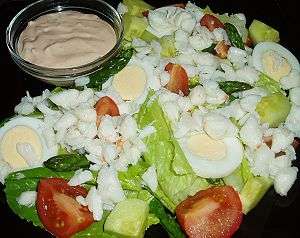Louis dressing
|
A Crab Louie salad with Louis dressing on the side | |
| Type | Salad dressing |
|---|---|
| Place of origin | United States |
| Main ingredients | Mayonnaise, red chili sauce, green onions, green chili peppers |
|
| |
Louis dressing is a salad dressing based on mayonnaise, to which has been added red chili sauce, minced green onions, and minced green chili peppers. It is commonly used as a dressing for salads featuring seafood, such as a Crab (Crab Louis, the King of Salads) or Shrimp Louis.[1][2]
Origin
The origin of the dressing is disputed. The Olympic Club in Seattle, The Davenport Hotel in Spokane, Washington, Solari’s Restaurant, Bergez-Frank’s Old Poodle Dog Restaurant and the St. Francis Hotel in San Francisco, and the Bohemian in Portland all claim to be the home of the dressing, with the invention in either the 1900s or 1910s. In all cases, the original salad was made with Dungeness crab.[1][2][3]
This is taken from The American Heritage Cookbook published 1964.
Crab Louis was created by the chef at the Olympic Club in Seattle, Washington. When the Metropolitan Opera Company played Seattle in 1904, Enrico Caruso kept ordering the salad until none was left in the kitchen.
The Dressing: 1 cup mayo, 1/4 cup chili sauce, 2 Tbsp finely diced or grated onion, 2 Tbsp fresh parsley, chopped fine, A pinch or two of cayenne, 1/2 cup heavy cream, whipped
Combine the first 5 ingredients then gently fold in the whipped cream and refrigerate. Shred lettuce, arrange on a platter, and heap 1 1/2 pounds of crab meat, picked over and flaked on top. Garnish with hard boiled eggs, fresh tomato slices, and slices of avocado or artichoke hearts. Pour the Louis dressing over all. Serves 4
References
- 1 2 History of Salads and Salad Dressings
- 1 2 www.thedavenporthotel.com
- ↑ Peters, Erica J., San Francisco: A Food Biography. New York: Rowman & Littlefield, 2013, p. 182.
External links
| Wikibooks Cookbook has a recipe/module on |

.jpg)